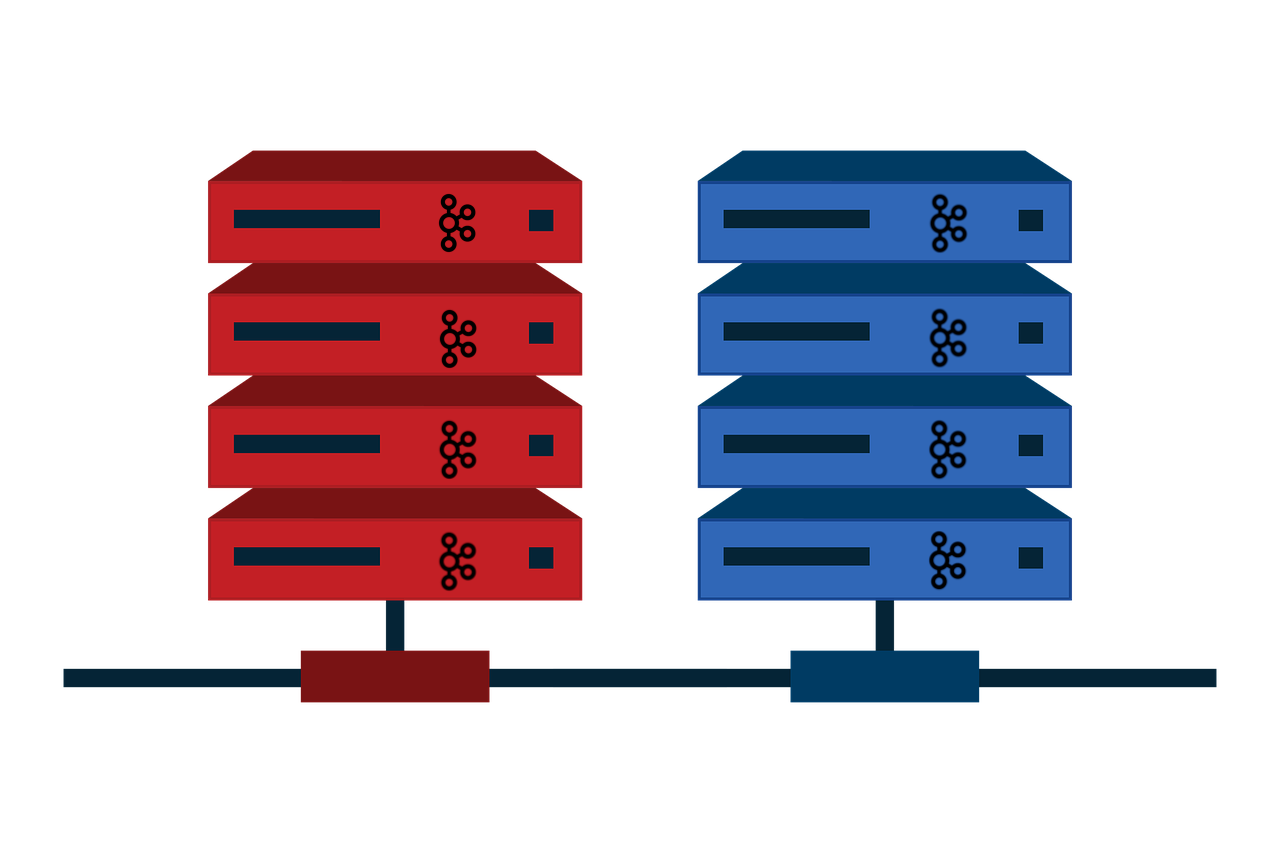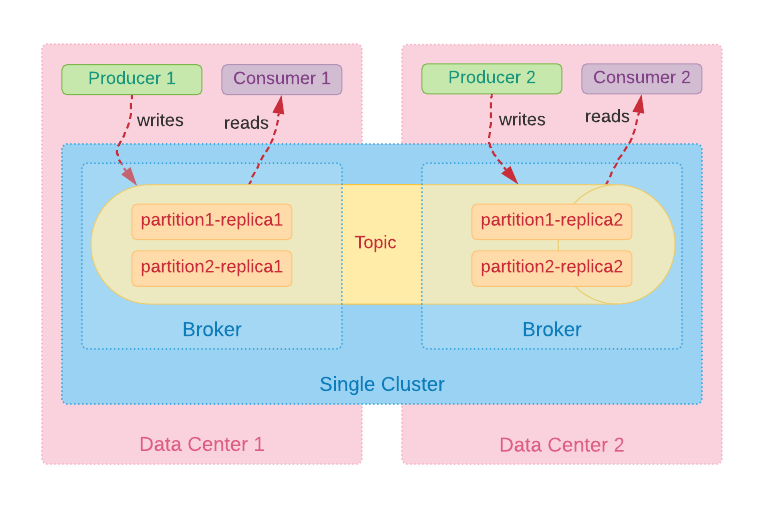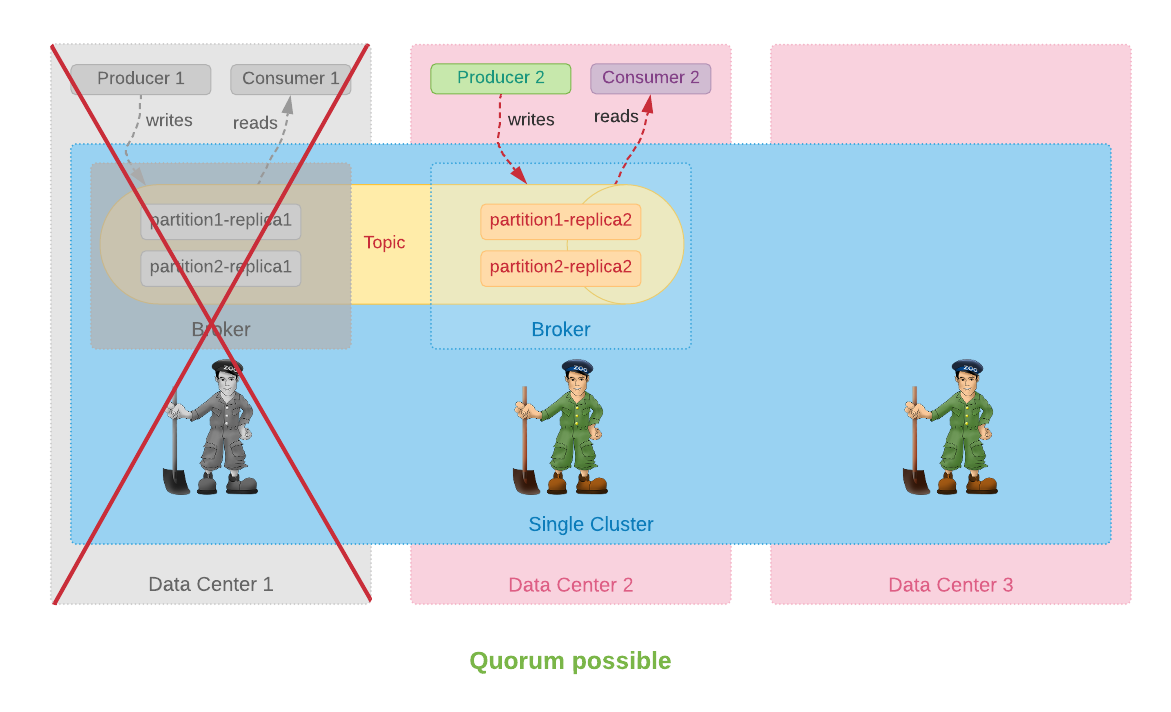Kafka in multiple DCs

Intro
Shortly after you make a decision that Kafka is the right tool for solving your problem you will probably wonder how to install a Kafka cluster that will survive various outage scenarios (no one likes to be woken up in the middle of the night to handle production incidents, right?).
While studying the topic you may end up with a conclusion that running your own Kafka cluster is not what you want as it can be both challenging and time-consuming. Fortunately, you can have someone else operate Kafka for you in a Kafka-as-a-service way (e.g. Confluent Cloud, Amazon MSK or CloudKarafka just to name a few).
But if you still decide to roll out your own Kafka cluster then you might come to a realisation that the only way to have a resilient Kafka installation is to use multiple data centers.
There are many ways how you can do this, each having their upsides and downsides, and we will go through them in this post.
Active-passive
The simplest solution that could come to mind is to just have 2 separate Kafka clusters running in two separate data centers and asynchronously replicate messages from one cluster to the other.
In this approach, producers and consumers actively use only one cluster at a time. The other cluster is passive, meaning it is not used if all goes well:

It is worth mentioning that because messages are replicated asynchronously it is not possible to give confirmation back to a producer that a message was stored not just in DC1 but also in DC2. In other words, producer could receive ACK for a particular message before it is sent to data center 2. As a consequence, a message could get lost if the first data center crashes before the message gets replicated.
Anyways, if the first data center goes down then the second one has to become active and take over the load:

Apart from the potential loss of messages which did not get replicated, another serious downside of this active-passive pattern is that it requires a human intervention. Someone has to be called in the middle of the night in order to just pull the lever and switch to the healthy cluster running in the other DC.
Unless consumers and producers are already running from a different data center that still remains healthy they will also need to do the switch, making the procedure even more complicated.
But probably the worst part is that you will need to deal with aligning offsets. Because clusters are totally independent the same message in the active cluster can get an entirely different offset in the passive one. And this can become a problem when you switch to the passive cluster because now consumers will need to somehow figure out where they have ended up reading. If done incorrectly the same messages will be read more than once, or worse - they will not be read at all.
Kafka in version 0.11.0.0 introduced exactly-once semantics, which gives applications an option to avoid having to deal with duplicates, but it requires a little bit more effort.
Please note that this exactly-once feature does not work across independent Kafka clusters.
Unfortunately, a similar procedure needs to be applied when switching back to the original cluster after it is finally restored. You need to again find the place where your consumers left off and smoothly switch to the repaired DC.
Yet another problem is aligning configuration changes. Both clusters are totally independent which means that if you decide to modify a topic in the active cluster (e.g. you add more partitions to a topic), you will need to do the same in the passive cluster as well.
Active-active
All in all, paying for a stand-by cluster that stays idle most of the time is not the most effective use of money. Alternatively, you could put the passive data center to work and get better throughput:

This active-active configuration looks quite convoluted at first, but starts to make more sense when you break it down. And it is worth understanding as it is commonly used in LinkedIn (at least based on the blog posts and tech talks they give) where Kafka was born.
As you can see, producers 1 and 2 publish messages to local clusters (represented by brokers A1 and A2) which are then propagated to aggregate clusters (to which brokers B1 and B2 belong).
From the consumers perspective this active-active architecture gives us interesting options on what messages we can read. We can decide to process only local messages (with consumer 1 and 2) or read messages from both local data centers (using consumers 3 and 4).
So imagine we have two data centers, one in San Francisco and one in New York. We assign users to one of the data centers, whichever is closer to the user, so that users can enjoy reduced latency. Now, if a user is somewhere in the bay area we will assign her to the SF data center. And until the user stays close to this data center we can quickly process her messages using a consumer which is reading from the local cluster. But then if the same user decides to go on a business trip to the other coast and her messages get published to the NY DC then the consumer in the San Francisco data center will not get the message. And this is where aggregate clusters come into play because they get messages from both local DCs. Depending on a scenario, we may choose to read local messages and make our apps more responsive to users’ actions or wait for aggregate cluster to eventually get hold of these messages and better handle the weird edge-cases where users’ data is stored across multiple data centers.
But if you favour simplicity, it could also make sense to allow consumption only from the aggregate clusters (then only consumers 3 and 4 could read messages) which can potentially make reasoning easier and help achieve a more straightforward disaster-recovery procedure (at the cost of increased latency).
Going back to this complex active-active diagram, when looking at it you might wonder why over-complicate and have those aggregate clusters if instead you could just put mirror makers in each of the data centers where they would copy data from A1 over to A2 and vice versa? That would have been simpler, but unfortunately it would also introduce loops. So a message published to A1 would have been replicated to A2 by mirror maker in DC2, but then mirror maker in DC1 would have copied it back to A1. Here is an example of a loop (just follow the orange arrows from 1. to 5.):

Stretched cluster
Whether you choose to go with active-passive or active-active you will still need to deal with complicated monitoring as well as complicated recovery procedures. And this can get pretty overwhelming when designing and setting up.
But if data centers are close to each other (e.g. availability zones within the same region) then there is a much simpler alternative commonly called “stretched cluster”.
It is basically a one big cluster stretched over multiple data centers (hence the name):

Probably the best part about stretched cluster is that we are not forced into devising a complex disaster-recovery instruction. We just need to keep our single cluster healthy by monitoring standard Kafka’s metrics instead of having to deal with 2 (active-passive) or 4 (active-active) separate clusters.
Another great thing is that we do not need to worry about aligning offsets because data is no longer mirrored between independent clusters. We can simply rely on Kafka’s replication functionality to copy messages over to the other data center while making sure all replicas are in-sync.
Rack-awareness
However, for this to work properly we need to ensure that each partition in one DC has a replica in the other DC:

It is necessary because when disaster strikes then all partitions will need to be handled by the remaining data center:

By default Kafka is not aware that our brokers are running from different data centers and it could potentially put replicas of the same partition inside one DC.
But if we take advantage of the rack-awareness feature and assign Kafka brokers to their corresponding data centers then Kafka will try to evenly distribute replicas over available DCs.
What about ZooKeepers?
Another important caveat when choosing stretched cluster is that it actually requires at least 3 data centers. Otherwise quorum will not be possible to achieve when one DC goes down because the remaining ZooKeeper could not form the majority on its own:

If we just add a third ZooKeeper running somewhere off-site then we can get the majority of votes (2 > 1) in case of an outage:

As shown on the diagram, the third data center does not necessarily need to run any Kafka brokers, but a healthy third ZooKeeper is a must for the stretched cluster to keep on running.
The good news is that there is an improvement proposal to get rid of ZooKeeper, meaning Kafka will provide its own implementation of a consensus algorithm. Even though this will surely simplify managing a Kafka installation it will unlikely render the third DC useless. No matter the algorithm being used, we will still need another data center to maintain quorum.
Last thoughts
Depending on the scale of a business, whether it is running locally or all over the globe, different approaches can be used. Please, do not get the wrong idea that one type of architecture is bad while the other is superior. There is no silver bullet and each option has its shortcomings.
Even when you look at how big tech giants (like for example the aforementioned LinkedIn) are deploying Kafka then you could see they are often taking a mixed approach. If it makes sense they run a passive cluster on a side, go for a stretched cluster to handle users concentrated in one geographical region or choose active-active configuration if data centers are further away. And none of these approaches are bad, as long as they solve a certain use-case.
Want to learn more?
Here are 2 tech talks by Gwen Shapira where she discusses different cluster architectures in more detail: